Chenchen Ding
HaLoRA: Hardware-aware Low-Rank Adaptation for Large Language Models Based on Hybrid Compute-in-Memory Architecture
Feb 27, 2025Abstract:Low-rank adaptation (LoRA) is a predominant parameter-efficient finetuning method to adapt large language models (LLMs) for downstream tasks. In this paper, we first propose to deploy the LoRA-finetuned LLMs on the hybrid compute-in-memory (CIM) architecture (i.e., pretrained weights onto RRAM and LoRA onto SRAM). To address performance degradation from RRAM's inherent noise, we design a novel Hardware-aware Low-rank Adaption (HaLoRA) method, aiming to train a LoRA branch that is both robust and accurate by aligning the training objectives under both ideal and noisy conditions. Experiments finetuning LLaMA 3.2 1B and 3B demonstrate HaLoRA's effectiveness across multiple reasoning tasks, achieving up to 22.7 improvement in average score while maintaining robustness at various noise levels.
Registering Source Tokens to Target Language Spaces in Multilingual Neural Machine Translation
Jan 06, 2025



Abstract:The multilingual neural machine translation (MNMT) enables arbitrary translations across multiple languages by training a model with limited parameters using parallel data only. However, the performance of such MNMT models still lags behind that of large language models (LLMs), limiting their practicality. In this work, we address this limitation by introducing registering to achieve the new state-of-the-art of decoder-only MNMT models. Specifically, we insert a set of artificial tokens specifying the target language, called registers, into the input sequence between the source and target tokens. By modifying the attention mask, the target token generation only pays attention to the activation of registers, representing the source tokens in the target language space. Experiments on EC-40, a large-scale benchmark, show that our method outperforms related methods driven by optimizing multilingual representations. We further scale up and collect 9.3 billion sentence pairs across 24 languages from public datasets to pre-train two models, namely MITRE (multilingual translation with registers). One of them, MITRE-913M, outperforms NLLB-3.3B, achieves comparable performance with commercial LLMs, and shows strong adaptability in fine-tuning. Finally, we open-source our models to facilitate further research and development in MNMT: https://github.com/zhiqu22/mitre.
Improving Language Transfer Capability of Decoder-only Architecture in Multilingual Neural Machine Translation
Dec 03, 2024



Abstract:Existing multilingual neural machine translation (MNMT) approaches mainly focus on improving models with the encoder-decoder architecture to translate multiple languages. However, decoder-only architecture has been explored less in MNMT due to its underperformance when trained on parallel data solely. In this work, we attribute the issue of the decoder-only architecture to its lack of language transfer capability. Specifically, the decoder-only architecture is insufficient in encoding source tokens with the target language features. We propose dividing the decoding process into two stages so that target tokens are explicitly excluded in the first stage to implicitly boost the transfer capability across languages. Additionally, we impose contrastive learning on translation instructions, resulting in improved performance in zero-shot translation. We conduct experiments on TED-19 and OPUS-100 datasets, considering both training from scratch and fine-tuning scenarios. Experimental results show that, compared to the encoder-decoder architecture, our methods not only perform competitively in supervised translations but also achieve improvements of up to 3.39 BLEU, 6.99 chrF++, 3.22 BERTScore, and 4.81 COMET in zero-shot translations.
Languages Transferred Within the Encoder: On Representation Transfer in Zero-Shot Multilingual Translation
Jun 12, 2024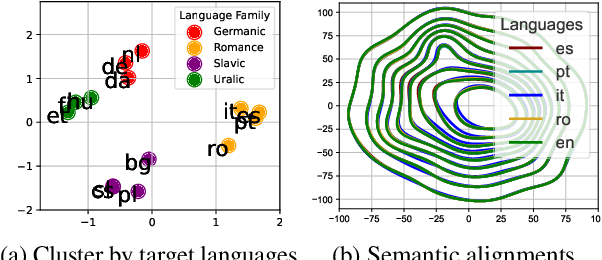


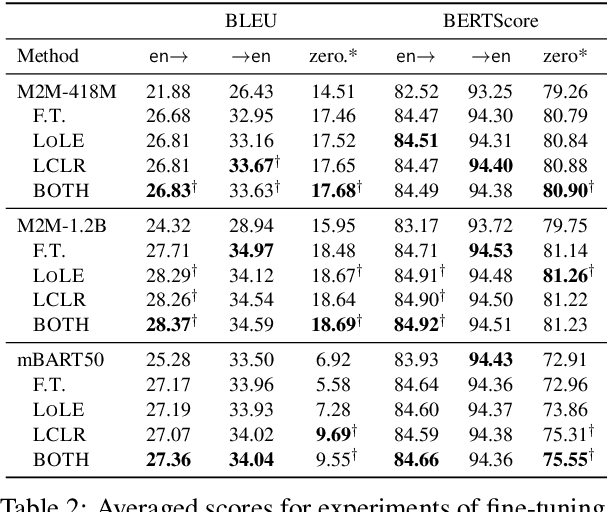
Abstract:Understanding representation transfer in multilingual neural machine translation can reveal the representational issue causing the zero-shot translation deficiency. In this work, we introduce the identity pair, a sentence translated into itself, to address the lack of the base measure in multilingual investigations, as the identity pair represents the optimal state of representation among any language transfers. In our analysis, we demonstrate that the encoder transfers the source language to the representational subspace of the target language instead of the language-agnostic state. Thus, the zero-shot translation deficiency arises because representations are entangled with other languages and are not transferred effectively to the target language. Based on our findings, we propose two methods: 1) low-rank language-specific embedding at the encoder, and 2) language-specific contrastive learning of the representation at the decoder. The experimental results on Europarl-15, TED-19, and OPUS-100 datasets show that our methods substantially enhance the performance of zero-shot translations by improving language transfer capacity, thereby providing practical evidence to support our conclusions.
Outlier-Aware Training for Low-Bit Quantization of Structural Re-Parameterized Networks
Feb 11, 2024



Abstract:Lightweight design of Convolutional Neural Networks (CNNs) requires co-design efforts in the model architectures and compression techniques. As a novel design paradigm that separates training and inference, a structural re-parameterized (SR) network such as the representative RepVGG revitalizes the simple VGG-like network with a high accuracy comparable to advanced and often more complicated networks. However, the merging process in SR networks introduces outliers into weights, making their distribution distinct from conventional networks and thus heightening difficulties in quantization. To address this, we propose an operator-level improvement for training called Outlier Aware Batch Normalization (OABN). Additionally, to meet the demands of limited bitwidths while upkeeping the inference accuracy, we develop a clustering-based non-uniform quantization framework for Quantization-Aware Training (QAT) named ClusterQAT. Integrating OABN with ClusterQAT, the quantized performance of RepVGG is largely enhanced, particularly when the bitwidth falls below 8.
A Crucial Parameter for Rank-Frequency Relation in Natural Languages
Feb 01, 2024Abstract:$f \propto r^{-\alpha} \cdot (r+\gamma)^{-\beta}$ has been empirically shown more precise than a na\"ive power law $f\propto r^{-\alpha}$ to model the rank-frequency ($r$-$f$) relation of words in natural languages. This work shows that the only crucial parameter in the formulation is $\gamma$, which depicts the resistance to vocabulary growth on a corpus. A method of parameter estimation by searching an optimal $\gamma$ is proposed, where a ``zeroth word'' is introduced technically for the calculation. The formulation and parameters are further discussed with several case studies.
A Two Parameters Equation for Word Rank-Frequency Relation
May 02, 2022
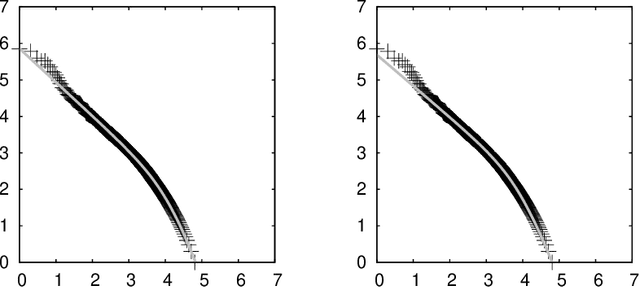
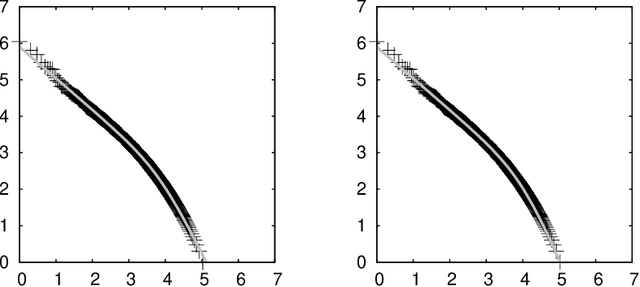
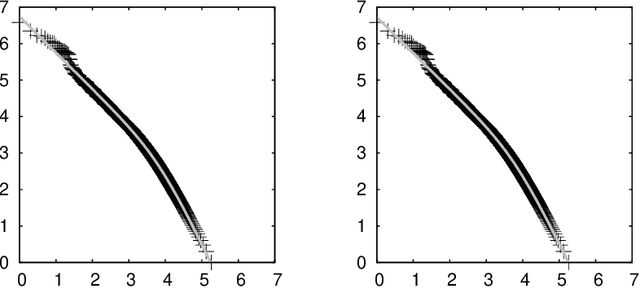
Abstract:Let $f (\cdot)$ be the absolute frequency of words and $r$ be the rank of words in decreasing order of frequency, then the following function can fit the rank-frequency relation \[ f (r;s,t) = \left(\frac{r_{\tt max}}{r}\right)^{1-s} \left(\frac{r_{\tt max}+t \cdot r_{\tt exp}}{r+t \cdot r_{\tt exp}}\right)^{1+(1+t)s} \] where $r_{\tt max}$ and $r_{\tt exp}$ are the maximum and the expectation of the rank, respectively; $s>0$ and $t>0$ are parameters estimated from data. On well-behaved data, there should be $s<1$ and $s \cdot t < 1$.
Hierarchical Softmax for End-to-End Low-resource Multilingual Speech Recognition
Apr 08, 2022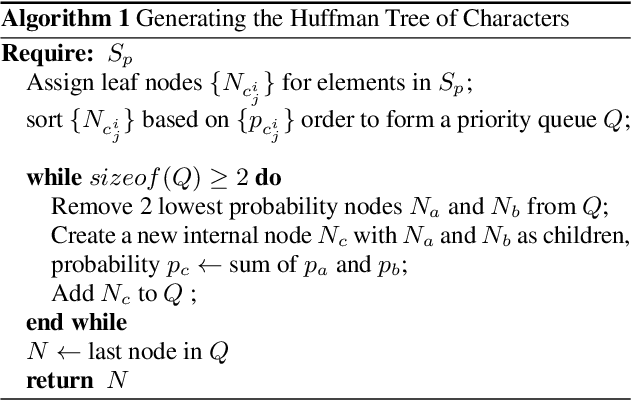


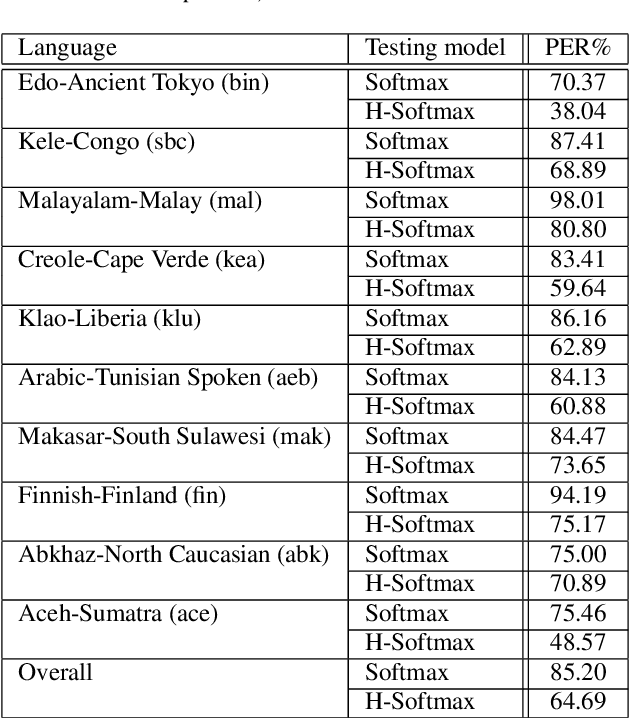
Abstract:Low resource speech recognition has been long-suffering from insufficient training data. While neighbour languages are often used as assistant training data, it would be difficult for the model to induct similar units (character, subword, etc.) across the languages. In this paper, we assume similar units in neighbour language share similar term frequency and form a Huffman tree to perform multi-lingual hierarchical Softmax decoding. During decoding, the hierarchical structure can benefit the training of low-resource languages. Experimental results show the effectiveness of our method.
Transliteration of Foreign Words in Burmese
Oct 26, 2021Abstract:This manuscript provides general descriptions on transliteration of foreign words in the Burmese language. Phenomena caused by phonetic and orthographic issues are discussed. Based on this work, we expect to gradually establish prescriptive guidelines to normalize the transliteration on modern words in Burmese.
 Add to Chrome
Add to Chrome Add to Firefox
Add to Firefox Add to Edge
Add to Edge